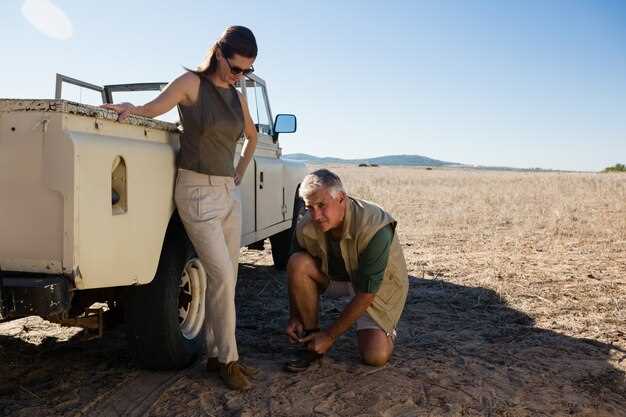
Off-roading enthusiasts often find themselves at a crossroads when it comes to selecting the perfect vehicle for their adventures. Two names consistently rise to the top of this conversation: the Jeep Wrangler and the Ford Bronco. Both vehicles have earned their reputations as off-road champions, but how do they truly compare in terms of performance when the trail gets tough? This article aims to delve deep into the capabilities of each vehicle, analyzing their features, powertrains, and design elements that set them apart in rugged terrains.
The Jeep Wrangler has been a staple in the off-road community for decades, known for its iconic design and rugged capabilities. Its four-wheel-drive systems, customizable features, and impressive ground clearance offer drivers remarkable confidence on challenging trails. Conversely, the Ford Bronco, newly reintroduced to the market, boasts modern technology and innovative designs that promise exceptional off-road performance. Its advanced suspension system and selectable drive modes cater to a variety of terrains, making it a worthy contender against the seasoned Wrangler.
In this performance comparison, we will look closely at various aspects such as engine power, suspension design, traction control systems, and overall durability. Understanding these elements will help prospective buyers make informed decisions, ultimately leading to more memorable off-road experiences. Buckle up as we explore the differences and similarities of the Jeep Wrangler and Ford Bronco, two titans of off-road performance.
Tire and Suspension Setup Differences for Off-Roading

The Jeep Wrangler and Ford Bronco are two iconic vehicles designed for off-road enthusiasts, but they differ significantly in their tire and suspension configurations, which directly impact their off-road performance.
Starting with the tires, the Jeep Wrangler typically comes equipped with more aggressive tire options that are focused on rugged terrain. The standard Wrangler variant often features all-terrain tires designed for both on-road and off-road use, while the Rubicon trim offers specialized mud-terrain tires for enhanced grip in challenging conditions. These tires are generally wider and have deeper treads, providing better traction on loose surfaces like mud and sand.
In contrast, the Ford Bronco has a more versatile tire setup, allowing for various choices depending on the model. The base Bronco features tires that are slightly less aggressive than those found on the Wrangler, targeting a balance between street use and off-road capabilities. However, higher trims like the Badlands offer options for beadlock-capable wheels and larger diameter tires, enhancing performance on rocky or uneven terrain.
When it comes to suspension systems, the Jeep Wrangler utilizes a solid front and rear axle setup, which is highly regarded for durability and articulation off-road. This configuration allows the Wrangler to maintain better wheel contact with the ground over uneven surfaces, improving stability and traction.
The Ford Bronco, on the other hand, employs an independent front suspension paired with a solid rear axle. This setup provides excellent ride quality and handling on-road while also delivering decent off-road performance. Moreover, the Bronco’s advanced suspension system includes options for adaptive dampers, which adjust to road conditions in real-time, enhancing comfort and control in various environments.
Another key difference lies in the adjustability of the suspension systems. The Jeep Wrangler features the renowned Rock-Trac system on Rubicon models, allowing drivers to switch between low-range gearing for serious off-road obstacles. The Bronco, however, boasts the G.O.A.T. (Goes Over Any Terrain) modes, which optimizes performance based on the selected terrain, providing a more customized off-road experience.
In summary, while both vehicles aim for off-road excellence, the Wrangler’s aggressive tire choices and rugged suspension provide unmatched durability and traction, making it a powerhouse in challenging terrains. The Bronco, with its versatile tire options and adaptive suspension attributes, offers a well-rounded performance suitable for a variety of conditions, appealing to those who seek adventure across multiple terrains.
Powertrain Options and Their Impact on Traction
The powertrain options for both the Jeep Wrangler and Ford Bronco significantly influence their off-road performance and traction capabilities. Each vehicle offers a range of engines and transmission types, all designed to optimize power delivery and control in challenging terrains.
The Jeep Wrangler offers several powertrain choices, including a 3.6-liter Pentastar V6 engine and a turbocharged 2.0-liter inline-four. The V6 delivers robust torque, which is crucial for low-speed crawling over obstacles. The turbocharged engine, while offering slightly less torque at low RPMs, compensates with improved fuel efficiency and responsiveness in various driving conditions. The option of an eTorque mild hybrid system in the Wrangler enhances torque delivery during acceleration, further improving traction, especially in slippery scenarios.
In contrast, the Ford Bronco features a 2.3-liter EcoBoost inline-four and a 2.7-liter EcoBoost V6. The 2.3-liter engine provides a balanced mix of power and efficiency, making it suitable for both daily driving and off-road adventures. The 2.7-liter V6 offers substantially more torque, which can be beneficial in rugged terrains where extra pulling power is essential. Both engines are paired with a 7-speed manual or a 10-speed automatic transmission, designed to ensure power is smoothly delivered across a variety of surfaces.
Traction is further enhanced by the driveline systems in both vehicles. The Wrangler features Jeep’s renowned 4×4 systems, including the Rock-Trac and Command-Trac systems, providing drivers with the ability to select the optimal mode for the terrain they encounter. With features like low-range gearing and locking differentials, the Wrangler excels in maintaining traction on rocky, muddy, or uneven surfaces.
Similarly, the Bronco is equipped with advanced 4×4 technology, including a two-speed transfer case and optional electronic locking differentials. These features allow the Bronco to adapt to different off-road situations effectively, ensuring that power is sent to the wheels with the best grip. The G.O.A.T. (Goes Over Any Terrain) Modes in the Bronco further enhance traction by adjusting throttle response and traction control settings based on the selected terrain type.
Ultimately, the choice of powertrain significantly impacts how each vehicle performs off-road. Factors such as engine output, torque availability, and the effectiveness of the 4×4 system determine the ability to navigate difficult landscapes. Potential buyers should consider their off-road needs and select a powertrain that aligns with the specific environments they plan to tackle.
Real-World Off-Road Testing: Hill Climbing and Water Fording

Both the Jeep Wrangler and Ford Bronco are celebrated for their off-road capabilities, but real-world performance can vary significantly in challenging terrains such as hill climbing and water fording. This section examines how each vehicle responds to these demanding conditions.
Hill Climbing: The Wrangler is renowned for its robust engine options and exceptional torque, giving it an edge on steep inclines. With features like the Rock-Trac four-wheel-drive system and high ground clearance, the Wrangler can tackle steep grades with impressive traction. Its absence of rear overhang also allows for better approach angles, which is crucial when navigating steep hills.
The Bronco, on the other hand, boasts advanced off-road technology, including the G.O.A.T. (Goes Over Any Terrain) modes, which optimize the vehicle’s performance based on the terrain. The available 7-speed manual transmission provides precise control during ascents, making it easier to maintain momentum. Users have noted that while the Bronco performs admirably, it occasionally lacks the effortless climbing ability seen in the Wrangler, particularly on extremely steep surfaces.
Water Fording: In terms of water fording, both models showcase impressive capabilities. The Wrangler offers a water fording depth of up to 30 inches, benefiting from sealed electrical connections and elevated air intakes. This allows drivers to cross streams or flooded areas with confidence, knowing the vehicle can withstand considerable submersion without experiencing damage.
The Bronco matches this with a similar fording depth, also rated at 33.5 inches with the right configuration. Its design includes clever drainage systems that direct water away from critical components, which enhances reliability during water crossings. Enthusiasts have reported that the Bronco’s wider stance provides additional stability when maneuvering in water, although it may feel heavier compared to the Wrangler.
In conclusion, both the Jeep Wrangler and Ford Bronco excel in off-road scenarios like hill climbing and water fording, but their approaches differ. The Wrangler’s proven track record and continuous torque deliver an experience that is hard to beat, while the Bronco introduces modern technology and stability that appeals to hardcore off-roaders. Ultimately, the choice may boil down to personal preference and specific off-road needs.
